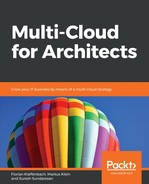Book Description
Your one-stop guide to work with multiple cloud service providers
Key Features
- A practical step-by-step guide that will teach you to architect effective Cloud computing solutions and services efficiently
- You will learn the key differences in both platforms and how you can interconnect them to each other
- Eliminate the pain-points of architecting, interconnect and managing multi-cloud services and solutions.
Book Description
With the passing of time and with technology evolving, organizations all around the globe, from small- to medium-sized enterprises through to companies that are fully equipped, have started migrating or adapting to cloud computing. If you are looking at adapting entirely to any cloud and its services, this book will be your go-to guide to find perfect solutions, irrespective of the size of your infrastructure.
This book will teach you effective solutions for overcoming various implementation scenarios. Our book covers two major cloud platforms (AWS and Azure) and provides practical use cases. You will start by designing the building blocks for infrastructure solutions that will involve core cloud platform services, such as compute, networking, storage, and identity, through various cloud providers. You will be able to plan and design solutions across major cloud providers and streamline interconnections and identities. Finally, you will understand the differences between, and the behavior of, both platforms, and you will be able to plan interconnects and identities for single-instance management.
By the end of this book, you will know everything you need in order to be able to architect a multi-cloud solution for your organization.
What you will learn
- Get to grips with different cloud offerings according to service and availability model
- Choose your cloud model, depending on real-world requirements
- Become familiar with interconnecting and designing multi-cloud solutions according to network, identity, and application
- Interconnect major cloud providers and frameworks, such as Microsoft Azure/Azure Stack, and AWS, and manage hosting solutions
- Resolve key show stoppers in a multi-cloud environment
- Familiarize yourself with example architectures based on real-world projects and solutions
Who this book is for
If you are a Cloud Architect, Solutions architect, system/network administrator, or a DevOps engineers aware of Cloud solutions and keen to successfully architect them to your organization then, this book is for you.
